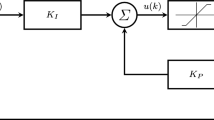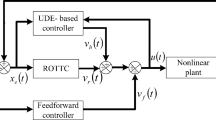Abstract
In feedback control, the presence of system uncertainties cause system state trajectories to deviate from their ideal responses. In practice, a subset of these trajectories can be more critical than the rest due to physical and/or performance characteristics associated with a problem of interest. Hence, it is desired not only to have performance guarantees on the entire system state trajectories but also to be able to adjust the resulting worst-case performance bound for that critical subset. Yet, in model reference adaptive control of uncertain dynamical systems, assigning performance bounds on a subset of system trajectories is not trivial. This paper addresses this gap by proposing a new control architecture that has the capability to enforce a user-defined performance bound on the selected subset of dynamical system trajectories, entitled as partially adjustable performance guarantees. The proposed architecture is predicated on a set-theoretic treatment and utilizes a two-level constructive design framework. In particular, we first form an auxiliary state dynamics in order to construct the auxiliary system error vector between uncertain dynamical system states and this auxiliary dynamics states. This construction aids a control designer to weigh each element of the auxiliary system error vector independently, while enforcing performance bounds on the norm of this error vector. Then, a command governor mechanism is designed for driving a feasible user-selected subset of system states to a close (and user-controllable) neighborhood of the corresponding reference model states. This results in adjustable performance guarantees on a subset of system error trajectories.














Similar content being viewed by others
Notes
Versions of the auxiliary state dynamics given by (18) and (19) are previously utilized by the authors of [21,22,23,24,25] for reducing high-frequency oscillations that may occur in adaptive control systems. In this paper, however, the auxiliary state dynamics given by (18) and (19) is needed for an entirely different purpose to address the problem stated in Sect. 2; hence, our results are not related to those of [21,22,23,24,25].
References
Bechlioulis CP, Rovithakis GA (2008) Robust adaptive control of feedback linearizable MIMO nonlinear systems with prescribed performance. IEEE Trans Autom Control 53(9):2090–2099
Bechlioulis CP, Rovithakis GA (2009) Adaptive control with guaranteed transient and steady state tracking error bounds for strict feedback systems. Automatica 45(2):532–538
Bechlioulis CP, Rovithakis GA (2010) Prescribed performance adaptive control for multi-input multi-output affine in the control nonlinear systems. IEEE Trans Autom Control 55(5):1220–1226
Ngo KB, Mahony R, Jiang ZP (2005) Integrator backstepping using barrier functions for systems with multiple state constraints. In: IEEE conference on decision and control
Arabi E, Gruenwald BC, Yucelen T, Nguyen NT (2018) A set-theoretic model reference adaptive control architecture for disturbance rejection and uncertainty suppression with strict performance guarantees. Int J Control 91:1195–1208
Arabi E, Yucelen T (2018) Set-theoretic model reference adaptive control with time-varying performance bounds. Int J Control. https://doi.org/10.1080/00207179.2018.1442026
Ames AD, Xu X, Grizzle JW, Tabuada P (2016) Control barrier function based quadratic programs for safety critical systems. IEEE Trans Autom Control 62(8):3861–3876
Romdlony MZ, Jayawardhana B (2016) Stabilization with guaranteed safety using control Lyapunov-barrier function. Automatica 66:39–47
Ames AD, Grizzle JW, Tabuada P (2014) Control barrier function based quadratic programs with application to adaptive cruise control. In: Conference on decision and control, pp 6271–6278
L’Afflitto A (2018) Robust adaptive control for constrained dynamical systems following unreliable reference signals. In: 2018 annual American control conference (ACC), IEEE, pp 4056–4061
L’Afflitto A, Blackford TA (2018) Constrained dynamical systems, robust model reference adaptive control, and unreliable reference signals. Int J Control. https://doi.org/10.1080/00207179.2018.1489147
L’Afflitto A (2018) Barrier Lyapunov functions and constrained model reference adaptive control. IEEE Control Syst Lett 2(3):441–446
Fravolini ML, Arabi E, Yucelen T (2018) A model reference adaptive control approach for uncertain dynamical systems with strict component-wise performance guarantees. In: AIAA guidance, navigation, and control conference
Yucelen T, Arabi E, Balakrishnan S (2018) A structural condition for model reference adaptive control systems to enforce partial performance constraints. In: AIAA guidance, navigation, and control conference
Arabi E, Yucelen T, Balakrishnan S (2018) A set-theoretic model reference adaptive control architecture with partially adjustable strict performance guarantees: a command governor approach. In: American control conference
Lavretsky E, Wise K (2012) Robust and adaptive control with aerospace applications. Springer, Berlin
Narendra KS, Annaswamy AM (2012) Stable adaptive systems. Courier Corporation, Chelmsford
Ioannou PA, Sun J (2012) Robust adaptive control. Courier Corporation, Chelmsford
Ren B, Ge SS, Tee KP, Lee TH (2010) Adaptive neural control for output feedback nonlinear systems using a barrier Lyapunov function. IEEE Trans Neural Netw 21(8):1339–1345
Tee KP, Ge SS, Tay EH (2009) Barrier Lyapunov functions for the control of output-constrained nonlinear systems. Automatica 45(4):918–927
Stepanyan V, Krishnakumar K (2010) MRAC revisited: guaranteed performance with reference model modification. In: American control conference, pp 93–98
Lavretsky E (2011) Reference dynamics modification in adaptive controllers for improved transient performance. In: AIAA guidance, navigation, and control conference, pp 1–13
Harl N, Rajagopal K, Balakrishnan S (2011) Modified state observer for orbit uncertainty estimation. In: AIAA guidance, navigation, and control conference
Gibson TE, Annaswamy AM, Lavretsky E (2012) Adaptive systems with closed-loop reference models: stability, robustness and transient performance. arXiv preprint arXiv:1201.4897
Yucelen T, De La Torre G, Johnson EN (2014) Improving transient performance of adaptive control architectures using frequency-limited system error dynamics. Int J Control 87(11):2383–2397
Arabi E, Yucelen T, Gruenwald BC (2017) Model reference adaptive control for uncertain dynamical systems with unmatched disturbances: a command governor-based approach. In: Zhang D, Wei B (eds) Robotics and mechatronics for agriculture. CRC Press, Boca Raton
Yucelen T, Haddad WM (2012) A robust adaptive control architecture for disturbance rejection and uncertainty suppression with \(\cal{L}_\infty \) transient and steady-state performance guarantees. Int J Adapt Control Signal Process 26:1024–1055
Chellaboina V, Haddad WM, Bernstein DS, Wilson DA (2000) Induced convolution operator norms of linear dynamical systems. Math Control Signals Syst 13:216–239
Haddad WM, Chellaboina V (2008) Nonlinear dynamical systems and control: a Lyapunov-based approach. Princeton University Press, Princeton
Chen W, Chowdhury FN (2007) Simultaneous identification of time-varying parameters and estimation of system states using iterative learning observers. Int J Syst Sci 38(1):39–45
Hidayat Z, Babuska R, De Schutter B, Nunez A (2011) Observers for linear distributed-parameter systems: a survey. In: 2011 IEEE international symposium on robotic and sensors environments (ROSE). IEEE, pp 166–171
Paesa D, Franco C, Llorente S, Lopez-Nicolas G, Saguez C (2011) Reset adaptive observer for a class of nonlinear systems. IEEE Trans Autom Control 57(2):506–511
Abdelhedi A, Saadi W, Boutat D, Sbita L (2018) Backstepping and sliding modes for observer design of distributed parameter system. Trans Inst Meas Control 40(2):542–549
Kamran NN, Drakunov SV (2015) Observer design for distributed parameter systems. In: 2015 proceedings of the conference on control and its applications. SIAM, pp 475–482
Coronel-Escamilla A, Torres F, Gómez-Aguilar J, Escobar-Jiménez R, Guerrero-Ramírez G (2018) On the trajectory tracking control for an scara robot manipulator in a fractional model driven by induction motors with pso tuning. Multibody Syst Dyn 43(3):257–277
Solís-Pérez J, Gómez-Aguilar J, Torres L, Escobar-Jiménez R, Reyes-Reyes J (2019) Fitting of experimental data using a fractional Kalman-like observer. ISA Trans 88:153–169
Coronel-Escamilla A, Gómez-Aguilar J, Torres L, Escobar-Jimnez R, Olivares-Peregrino V (2017) Fractional observer to estimate periodical forces. ISA Trans 82:30–41. https://doi.org/10.1016/j.isatra.2017.11.003
Pomet JB, Praly L (1992) Adaptive nonlinear regulation: estimation from the Lyapunov equation. IEEE Trans Autom Control 37(6):729–740
Author information
Authors and Affiliations
Corresponding author
Additional information
This research was supported by the National Aeronautics and Space Administration under Grant NNX15AM51A.
Appendix: Necessary definitions
Appendix: Necessary definitions
For completeness, this appendix presents two key definitions used in our main results.
Definition 1
(Projection operator) Let a convex hypercube in \({\mathbb {R}}^n\) be defined as \(\Omega = \big \{\theta \in {\mathbb {R}}^n : (\theta ^\mathrm {min}_i \le \theta _i \le \theta ^\mathrm {max}_i )_{i=1,2,\ldots ,n}\big \}\), where \((\theta ^\mathrm {min}_i,\)\(\theta ^\mathrm {max}_i)\) represent the minimum and maximum bounds for the ith component of the n-dimensional parameter vector \(\theta \). Furthermore, let \(\Omega _\nu = \big \{\theta \in {\mathbb {R}}^n : (\theta ^\mathrm {min}_i + \nu \le \theta _i \le \)\(\theta ^\mathrm {max}_i - \nu )_{i=1,2,\ldots ,n}\big \}\) be the second hypercube for a sufficiently small positive constant \(\nu \), where \(\Omega _\nu \subset \Omega \). The definition of the projection operator \({\mathrm {Proj}}:{\mathbb {R}}^n \times {\mathbb {R}}^n \rightarrow {\mathbb {R}}^n\) is then component-wise given by
where \(y \in {\mathbb {R}}^n\) [16].
Based on Definition 1, it is well-known that
holds (see [16, 38] for details). One can also generalize (A.2) to matrices using \(\mathrm {Proj}_\mathrm {m}(\Theta , Y) = \bigl (\mathrm {Proj}(\mathrm {col}_{1}(\Theta ), \mathrm {col}_{1}(Y)),\ldots ,\)\( \mathrm {Proj}(\mathrm {col}_{m}(\Theta ),\)\( \mathrm {col}_{m}(Y))\bigl )\), where \(\Theta \in {\mathbb {R}}^{n \times m}\), \(Y\in {\mathbb {R}}^{n \times m}\), and \(\mathrm {col}_{i}(\cdot )\) denotes ith column operator. In this case \(\mathrm {tr} \ \bigl [(\Theta - \Theta ^{*})^\mathrm {T}(\mathrm {Proj}_\mathrm {m}(\Theta , Y) - Y)\bigl ]= \sum ^{m}_{i=1}\bigl [\mathrm {col}_{i}(\Theta - \Theta ^{*})^\mathrm {T}\)\((\mathrm {Proj}(\mathrm {col}_{i}(\Theta ), \mathrm {col}_{i}(Y)) - \mathrm {col}_{i}(Y))\bigl ] \le 0\) follows from (A.2).
Definition 2
(Generalized restricted potential function) For \(z \in {\mathbb {R}}^p\) and \(H\in {\mathbb {R}}^{p \times p}_{+}\), \(\phi (\Vert z\Vert _\mathrm {H})\), \(\phi : {\mathbb {R}}\rightarrow {\mathbb {R}}\), is called a generalized restricted potential function (generalized barrier Lyapunov function) on the set
where \(\epsilon \in {\mathbb {R}}_+\) is a-priori user-defined constant, when the next statements hold [5]:
- (i)
If \(\Vert z\Vert _\mathrm {H}=0\), then \(\phi (\Vert z\Vert _\mathrm {H})=0\).
- (ii)
If \(z \in \mathcal {D}_\epsilon \text { and } \Vert z\Vert _\mathrm {H}\ne 0\), then \(\phi (\Vert z\Vert _\mathrm {H})> 0\).
- (iii)
If \(\Vert z\Vert _\mathrm {H}\rightarrow \epsilon \), then \(\phi (\Vert z\Vert _\mathrm {H})\rightarrow \infty \).
- (iv)
\(\phi (\Vert z\Vert _\mathrm {H})\) is continuously differentiable on \(\mathcal {D}_\epsilon \).
- (v)
If \(z \in \mathcal {D}_\epsilon \), then \(\phi _d (\Vert z\Vert _\mathrm {H}) >0\), where
$$\begin{aligned} \phi _d (\Vert z\Vert _\mathrm {H}) \triangleq \frac{\mathrm {d}\phi (\Vert z\Vert _\mathrm {H})}{\mathrm {d}\Vert z\Vert ^2_\mathrm {H}}. \end{aligned}$$(A.4) - (vi)
If \(z \in \mathcal {D}_\epsilon \), then
$$\begin{aligned} 2 \phi _d (\Vert z\Vert _\mathrm {H}) \Vert z\Vert _\mathrm {H}^2 -\phi (\Vert z\Vert _\mathrm {H})> 0. \end{aligned}$$(A.5)
Rights and permissions
About this article
Cite this article
Arabi, E., Yucelen, T. & Balakrishnan, S. A command governor approach to set-theoretic model reference adaptive control for enforcing partially adjustable performance guarantees. Int. J. Dynam. Control 8, 675–689 (2020). https://doi.org/10.1007/s40435-019-00563-4
Received:
Revised:
Accepted:
Published:
Issue Date:
DOI: https://doi.org/10.1007/s40435-019-00563-4




